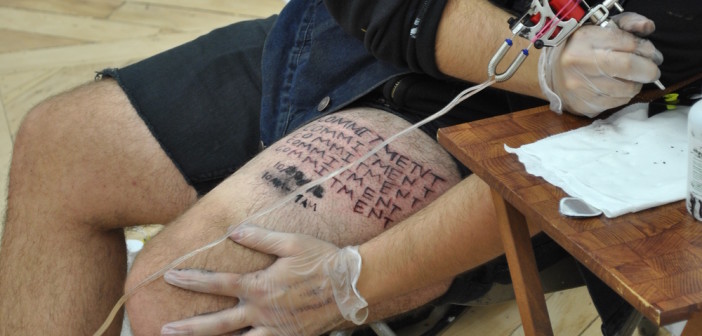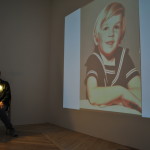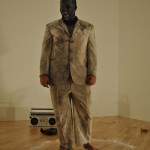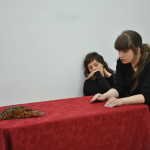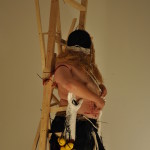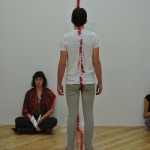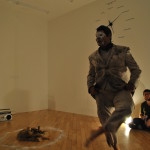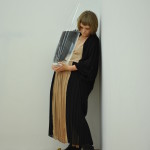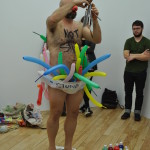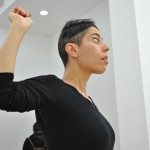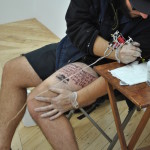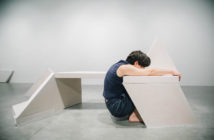Driving into Boston toward the Anthony Greaney Gallery on October 20th, I mentally prepared myself to witness some unusual stuff. I truly had no idea what to expect out of Time, Body, Space, Objects 2, curated by Vela Phelan and Alice Vogler. All I knew was that I was on my way to watch twelve different performance art pieces over the next twelve hours, and it was going to be a long, deep journey into largely uncharted territory for me.
Although I’ve been involved in the arts for more than ten years and encountered all kinds of esoteric subsets within the art world, performance is a practice whose works have always tested my boundaries of artistic acceptability. A large part of my difficulty in accepting performance as openly as I do other media is that until last year I rarely encountered it at all. Of course, I was aware of some of the more notable artists to emerge from the genre: Allan Kaprow, Vito Acconci, Chris Burden, Joseph Beuys, and so on; but in the Midwest the impact of these artist’s innovations was not readily apparent in the work I saw on a daily basis.
There were very few artists working peformatively in the Kansas City area, and when I did encounter one they projected more of a desire to be perceived as weird or shocking, or an attempt at masking a lack of skill and substance rather than finding the best means to present an idea or experience to the audience. There was no "performance scene" to speak of, only solitary, contextless efforts by unheard of artists, and my experiences left me questioning the validity of performance from one piece to the next.
My outlook changed when I moved to Massachusetts in the fall of 2011. One of the first art exhibits I saw after arriving was Holy Ghost, a month-long event of performance art and interventions that featured several Boston-area performance artists hosted by the Montserrat College of Art. This was my first exposure to an actual performance art community whose work was presented in a logical, well-reasoned manner. Through the following months I met more and more performance artists whose work I could either independently enjoy or appreciate through a bit of explanation, and my curiosity in the medium grew.
When I heard about Time, Body, Space, Objects 2, I knew I had to attend. Although I’ve always regarded performance as a generally weird practice, I’m also a fan of several things that most people consider strange. David Lynch films or the writings of William S. Burroughs or Will Self can take me to very bizarre, sometimes terrifying places that ultimately broaden and enrich my thoughts and worldview in exciting ways. I felt performance had the same potential, and this event seemed the perfect test to find out whether I could establish the proper connection with it or not.
As I neared the gallery I attempted to clear my head and shed expectations in preparation to absorb anything that came at me and, ready for anything, I went inside.
10:00 am
The Anthony Greaney Gallery is a fairly small space, roughly a 25’ x 20’ room with gleaming white walls, a polished hardwood floor, and a set of intensely bright fluorescent lights fixed to the vaulted ceiling. Mounted on the wall was a black clock with two long hands pointing to the name of each participating artist placed at the hour their performance was scheduled to start. This would be the same setting for the entire day, as the stipulations of the event specified that no lasting alterations could be made to the space during the performances, and anything brought in to perform a piece had to be removed at its conclusion.
The first artist, Tom Maio, had already begun when I arrived, and there were already about twenty people seated against the perimeter of the room watching him prepare to tattoo his left thigh. I found a seat close by and watched as he etched letters into his flesh with black ink. C. O. M. M. I. T. M. E. T? Commitmet? Checking over his work, Tom realizes the mistake and hastily transforms the ‘T’ into an ‘N’ and continues to spell out "commitment," the theme of all the pieces in Time, Body, Space, Objects 2. Once finished and satisfied with the result, Tom wiped the sweat from his brow with a spare paper towel and set about repeating the word just below the first.
Plenty of people are horrified by the prospect of tattooing themselves at all, and for those intimidated by tattoos this piece is a nightmare example of everything that is wrong with them. Sure, in this single, transitory moment Tom may think that it’s a clever little act for a performance piece, but what about ten years from now when the tattoo is still there? How will he feel then?
Personally, my guess is that even if he did come to regret the tattoo in ten years, by then he would have at least gotten used to it. What people intimidated by tattoos don’t understand is that although it leaves a permanent image on your skin, the long-term effects of the action are almost non-existent. Having a tattoo is no different than having freckles, or a mole, or a scar from an injury, or even having five toes for that matter. Our personalities and beings are subject to long, gradual processes of development, and the small minutiae that we allow to pass by each day without a second thought makes a greater contribution to who we are than a tattoo ever could. So in a sense, while Tom’s piece could serve as an extreme act of commitment, one absent of questioning or doubt, it could also be read as negating that idea by committing to something so superficial.
He ended up writing the word five times, taking up about the same amount of space as a large handprint, inscribed the date and time of the performance at the bottom, walked around the room to display the finished piece, then cleared out for the next performer.
11:00 am
Next in was Martine Viale, who began by setting up a black folding table and metal folding chair on one end of the room. On the table was a single plastic cup, and on the floor behind the setup was a black bag of materials along with a broom and dustpan. Martine began by standing a few feet away next to a hot water pot placed on the floor. Dressed in all black and having olive skin and dark hair, she held a solid, intense presence within the brightness of her surroundings.
Time, Body, Space, Objects 2
Anthony Greaney Gallery, Boston
Photo, Matthew Kuhlman
After a moment of staring straight ahead at the opposite wall, she plugged the water pot in and took a few steps forward toward the audience. From her pocket she produced a spool of black thread, cut off a segment, and holding either end of the thread in her hands inserted the thread up underneath her eyelids and used it to lift them all the way open. Watching her come so close to touching her own eye with the thread elicited a nauseating feeling that became prolonged as she held the pose looking downward to reveal as much of the whites of her eyes as possible. I relaxed a bit once she switched to other similar poses that weren’t as implicitly dangerous for her eyeballs, and after several minutes of this she slowly coiled the thread into the palm of her hand, then lifted it back up and pulled out a lighter to burn it. At first the thread danced away from the heat of the flame, but eventually it took hold and ran the length of the thread, turning it to a fine powder of ash.
Next, Martine crouched to the floor and spun a small top, watched it spin till it fell, then stood with her back against the wall and marked her height in black tape on the wall, along with two other pieces above forming a sort of arrow pointing upward. At this point it was almost impossible to decipher any meaning from these actions. I searched for a possible explanation or intention for what I was seeing as she selected one audience member to stand in front of and stare at face-to-face. At first the girl returned Martine’s unmoving stare, but after a minute or so of this standoff she began laughing despite her best attempts to stop. This struck me as an odd reaction. I wondered why she couldn’t help but laugh, then soon realized I was about to find out as Martine walked across the room and crouched down in front of me, locked into a stare about two feet away from my face.
I’ve always had an aversion to eye contact because it is inherently confrontational. In this situation I felt compelled to return the stare, and I realized why the other girl had begun laughing. The act of eye-to-eye staring creates that anticipation that something is about to happen. In more primitive times, this may have been the prelude to a fight to the death. In this modern setting we both know that won’t happen, but that instinct of heightened awareness and anticipation of an attack causes the brain to feel as if something is coming, but nothing does. After a time the body wants to initiate a response itself, one that will defuse the situation rather than either escalating it or wholly signaling subservience: laughter. I felt it welling inside of me and I held my ground by subtly chewing my tongue, attempting to slip into a calm meditative state where what was happening seemed far away and separate from me.
I also wondered why I was so opposed to laughing. For some reason I felt it was my intended duty in this situation to not respond, that if I were to react I would be inserting my own unauthorized presence into the performance. I was also keenly aware of the psychological aversion to displaying signs of weakness. After what seemed entirely too long, Martine lifted her shirt to expose her stomach, pulled out a black grease pencil and drew a basic house shape on her stomach, then continued our staring match for a moment longer before facing the crowd with the drawing on her stomach exposed, then covering it back up with her shirt and continuing the performance.
At this point I felt like I was in deep. There were obvious repetitions within the work: the use of so many black objects, the tape lines on the wall mimicking the roof of the house drawing, black thread, black pupils of the eye, but where was this heading? If I hadn’t happened to be selected for the staring contest, how might I have been able to form an interest in the things Martine was doing? The remaining twenty minutes of her piece consisted of a series of actions while seated at the table: tracing her hands several times onto sheets of computer paper, building a rectangular form out of rows of sugar cubes, dissolving sugar cubes in the cup using water from the hot water pot, sipping mouthfuls of the sugar water and dribbling it onto the pile of sugar cubes through a piece of paper with a hole cut in the center, turning the sugar cubes into a sticky mess that was cleaned up with the dustpan. All that remained of this series of actions was two of the sheets of paper that had several tracings of her hands on them, and using the sticky sugar residue, adhered the pieces of paper to her palms and ended the performance by walking like that to the opposite end of the room and facing the wall underneath the black tape marks she had placed there in the beginning.
The experience of watching this performance was similar to the feeling achieved in Zen practice when it dawns on you that rational thought will not provide the answer you seek. I knew that there was no way I could evaluate or interpret what I had just seen in a conventional sense. Martine’s performance involved so many small factors and actions, any of which could be abstractly expanded into a massive realm of conceptual thought, that I couldn’t mentally process the work beyond a series of events marked by intense moments of emotional investment and curiosity.
12:00 pm
In the back of my mind I was concerned that I was already feeling so psychologically unpinned this early in the performances, but fortunately the next artist, Daniel DeLuca, acted as a grounding force. Talking to him later, Daniel explained that his work is about creating context and relating art to audiences, which is precisely what he did.
Daniel darkened the room, set up a projector, took a seat off to the side, and delivered a lecture on the piece that Martine just performed, explaining how it fit into her larger body of work. In short, he explained how she generated comments on the analysis and over-analysis of art within the context of philosophy and academic thought surrounding it. He said that when self-awareness and self-reflection become meaning-making elements in the work it complicates things and creates an echo chamber of interpretation that results in a challenge of the viewer’s perception and expectation of objects, which rather eloquently described the overwhelmingly lost feeling I had from watching Martine’s performance.
As for DeLuca’s work itself, I had never encountered an artist who approached the creative process in such an abstract manner. I wondered if he even considered himself an artist as he was essentially holding an art appreciation lesson in the gallery, but being where I was, deep in the performance woods on the far fringe of the art world, I was becoming more comfortable with the preconceived rules and understandings of art fading away and approaching the point of singularity where life and art become one. And really, after talking with Daniel, I understood that to be his true goal—to act as a bridge that makes that merger possible.
To finish, Daniel gave an introduction for the next artist, Jeff Huckleberry. He showed several photos in chronological order of Jeff growing up, beginning with a portrait at about the age of two in a small sailor outfit that drew some jokes and banter from the audience at Daniel’s prodding. He didn’t actually say who the person was that he was showing in the series of photos, but proceeded through the photos until he reached more recent photos that I recognized as one of the people standing in the room. Following Daniel’s segment he set about preparing for his piece.
1:00 pm
Jeff Huckleberry’s entire performance was accompanied by his son quietly strumming an amplified acoustic guitar in the corner, experimentally changing the sounds with four different pedals and plucking random notes as if tuning the strings.
Jeff started by using a small pump to inflate a couple dozen long, hot dog—shaped balloons. He occasionally chatted back and forth with people as he worked and some of the balloons popped or deflated before he could tie them, but working diligently he had a satisfactory pile of the balloons ready after about ten minutes. In the middle of the room he rolled out a cloth tarp and placed two shallow wooden boxes on it, then stripped naked and changed into a white shirt and pants already splattered with dried paint. In one of the boxes he squeezed out thick layers of tempera paint in the order of the rainbow spectrum, filling the entire bottom of the box. Then after putting on a big red clown nose and stuffing a tennis ball into the crotch of his underwear he began pacing around the tarp.
Time, Body, Space, Objects 2
Anthony Greaney Gallery, Boston
Photo, Matthew Kuhlman
"It’s stupid. It’s not stupid. It’s stupid. It’s not stupid . . ." he muttered, waving each hand by his side with each option. While he had been engaged with the audience before, he now appeared to be completely focused on the argument in his head, and after a few laps around the tarp stopped and stripped down to his underwear. On his chest he wrote "not stupid" in black marker and "stupid" on his underwear before continuing his pacing and muttering as before.
After only a few more laps he began gathering up the balloons off the floor and began stuffing them all into his underwear. The ambient twanging of the guitar mixed with the squeaking sound of the balloons, and he was somewhat surprisingly able to fit them all in and continue his pacing. Soon after this he pulled an impossibly tangled wind chime from his bag and attempted to untangle the strings, holding it above the empty box as he continued circling around it. Eventually he fumbled the wind chime into the box and after pacing around a bit more, entered the box himself.
Pulling his underwear off, Jeff stuffed all the balloons into the bottom of the box as well as he could, popping several of them, then lifted the other box with the paint in it up over his head, allowing the paint to rain down over his naked body. He stood holding the box above him till his arms began to shake and give out from holding the stance, then ended the performance.
On the surface it might seem that Jeff was trying to do the weirdest thing he could possibly think of, which is absolutely true in a sense, but it is possible to discern a reason for doing the weirdest thing he possibly could. His piece showcased several references to feelings of insecurity. As an artist it is a familiar struggle to be caught in a loop of self-doubt and second-guessing all your ideas until you become frozen in your own inhibitions. And everyone can relate to having insecurities about their bodies or their personality, which Jeff referenced by stuffing his crotch with a tennis ball, labeling the crotch of his underwear as "stupid," and stuffing his underwear full of phallus-shaped objects. These could all be read as expressions of doubt about his adequacy as a man, which he is able to overcome during the performance and shed everything off, vulnerably exposing himself to everybody.
2:00 pm
Quite the opposite of Jeff was Erik Benjamin, who performed next. Following the absurdist show of exhibitionism was a piece in which the artist sat in the audience with a tape recorder as others performed the piece.
Two people, a man and a woman, entered the space and set up a sheet-music stand. In the middle of the floor was a stack of blue sheets of paper with the title of the piece on it, "Thirty-Five Years: A Chorus for the Stuck, Worn, Bound & Broken." The couple recited this title to begin the performance, then in unison began making several odd sound effect noises together, repeating each one twice. "Clunk! Clunk! Oofah! Oofah! Ripriprip! Ripriprip!" This went until after about seven minutes they repeated the title of the piece, and once again began the series over.
After the first cycle I grabbed one of the sheets of paper in search of an explanation for what we were witnessing. On the back I found a list of all the sound effects they were making along with the car trouble symptoms they were meant to describe. It was a comprehensive list including everything from vacuum leaks, to a loose heat shield, to a misadjusted tailgate latch.
After reading over the list I lost all interest. Before knowing what the sounds were there was at least an element of curiosity in wondering what they were, but once I knew that they were sounds of car problems I didn’t feel the need to listen anymore. The counterintuitive phenomenon that crude phonetic sounds are an effective way of diagnosing problems with a sophisticated machine like a car has the potential to create an interesting piece, but this execution seemed more like a test of how much nonsense the audience could endure.
3:00 pm
Time, Body, Space, Objects 2
Anthony Greaney Gallery, Boston
Photo, Matthew Kuhlman
Next into the room was Sandrine Schaefer. Sandrine began her piece with a large glass vase full of water sitting in the middle of the room as she walked along the wall eating a banana. Stopping in the corner, she finished the banana and dropped the peel on the ground, then stood staring at the vase for a moment. Eventually she walked over and picked up the vase, which turned out to have a hole in the bottom. She plugged the hole with her finger and walked back over to the corner. She did her best to contain the water but a steady trickle ran down her knuckles to the floor. The vase was tall enough that with the base of it held down by her waist, the top came up to her chin, and at an angle where she slightly rested her face in the opening while standing there.
After about fifteen minutes, showing fatigue from holding the weight of the vase, Sandrine carried the vase outside and allowed the contents to drain out onto the grass as she walked the length of a ledge outside the gallery. Once it was empty, she re-entered the gallery and placed the vase where she had been standing, then sat in the middle of the floor and ran out the remainder of her hour watching the condensation from her breath slowly evaporate from the surface of the glass.
For the audience it was a combined experience of watching the vase, watching Sandrine as she sat as still as possible, and fitting the pieces together. The piece could be viewed as a durational exhibition, or you could look further into the space that was occupied by Sandrine and these objects. The relations between these spaces and the transitory states of being that they went through are things that happen all around us every day, and Sandrine’s piece turns the viewer’s focus toward contemplating these ubiquitous principles of existence.
If she had stood there long enough, all the water in the vase would have eventually drained out and we would have seen the vase go through a full change in its state of being from full to empty. The corner she stood in was occupied, then empty save for the remnants of her being there: the vase and the banana peel. Then there was an immediate remnant of Sandrine in the vase while the condensation was there, but once it disappeared all immediate traces of her body ever being there were, too.
There were also several stratifications of states of permanence displayed within the piece, albeit abstractly. The least permanent object in the performance was the water. If all the water drained onto the floor it would have completely evaporated within a couple of hours. As an object, water holds a very short presence. After that is the banana peel. Given enough time, it would biodegrade and also disappear. Next is Sandrine herself. If enough time passed, Sandrine would also biodegrade and disappear, leaving only the vase. Then after hundreds of years the vase, and also building, would eventually disappear, leaving only the space itself as the one true permanent presence we can count on, at least as far as we’re aware.
4:00 pm
Nicholas Buffon used his time slot to order pizza and give everyone a pizza break. I won’t be such a douche as to contextualize it as anything beyond a pizza break, although it is a friendly reminder that it’s healthy to take a break every now and then, and that even in art not everything has to be serious.
5:00 pm
For his piece, Rob Andrews cut the lights and turned on a few small lamps to illuminate the space in a way similar to the dim glow of candlelight. He entered the room wearing a rubber Ronald Reagan mask and a suit that looked as if it had once been white but was buried in a pile of charcoal at one point. From his bag he pulled out several small radios and began handing them out to people in the audience. When he turned them on they were all tuned in to the same song, an unfamiliar blues or doo-wop tune, which grew louder with each radio he handed out until the air was thick with the sound.
In the middle of the room he placed a coyote pelt and two small statuettes and circled them with a ring of white powder. Right about when he was finished with this, Michael Jackson’s "Don’t Stop Till You Get Enough" started playing through the radios and Rob began energetically dancing around the room. This drew some smiles and laughs from the audience seeing a guy in a filthy suit and Reagan mask dance to a song that can get almost anyone onto the dance floor. Perhaps if he hadn’t been dressed like that an impromptu dance party would have broken out, but the whole scene was intimidating enough that nobody seemed prepared to participate in the piece even though Rob injected himself into the crowd and tried to pull people in along with him. The longer it went on the more unsettling the scene became. It was more than just dancing. Something about the lighting, the objects in the middle of the room, and the way he was moving was darkly ritualistic, and his dancing and jumping became more aggressive as hip-hop songs by El-P and Cannibal Ox started playing.
After about ten or fifteen minutes of dancing, Rob was becoming visibly worn out. He was starting to stagger and lurch in a delirium, audibly huffing and puffing inside the mask. A trail of gray liquid oozed from the cracks of the mask and down his neck onto his shirt. The music changed to a more subdued tune, eventually degenerating into a rumbling drone of static and muffled noise, and he moved toward the objects in the center. Picking up one of the statuettes, he broke the head off and lurched and shuffled around the ring swinging his arms loosely back and forth near the ground. After a time, he selected an audience member to give it to and did the same with the other statuette.
Next, he removed the coyote pelt from the ring and kneeled down caressing it for a moment before the music started back in and he danced with it slowly around the space. Eventually he kneeled and presented the pelt to one of the audience members, and moved back toward the ring in the middle of the circle where he finally peeled the mask off when he set foot inside of it. His face is covered in black grease paint, somewhat smeared from the sweat and the mask. He pulls a cigarette out of a pack and lights it, and while he smokes he glares around at the audience. Staggering in place, eyes rolling in his head, wagging his tongue at people and hissing, he behaves like either a crude drunk or a person possessed. At one point he unzips his pants and shakes his penis at someone in the audience.
Occasionally he let out with a vicious howl or a maniacal laugh, similar to one that an insane derelict used to belt out at a diner I went to in Milwaukee in the wee hours of the morning. It was a cross between a screech and a raspy laugh, one where the phlegm of the haggard lungs created the puffing sound of laughter until all the air had escaped. Moving down to all fours Rob began a long, low, sustained growl that turned into his leering and licking his lips at a woman nearby. His actions seemed increasingly uncontrollable and unhinged as he began licking up some of the white powder from the ring and fell on his side, convulsing and drooling. Soon awakening from his stupor, Rob put the mask back over his face and slowly moved about, cleaning up the powder, collecting the radios and the coyote pelt, and left the room.
6:00 pm
Next into the space was Ryan Hawk, who turned the lights back up and divided the room in half lengthwise with a roll of acetate, which he tacked about seven feet up on one wall, ran along the floor to the other side, and tacked the other end to the wall at about the same height. With a can of red spray paint he painted a line the entire length of the acetate, and using a tube of red lipstick drew a red line around his entire body dividing the left half from the right. Beginning from one end of the room, Ryan stood straddling the red line with his back to the wall and, very slowly, over the course of the hour walked to the other end of the room.
Time, Body, Space, Objects 2
Anthony Greaney Gallery, Boston
Photo, Matthew Kuhlman
This seemed like a piece that could be as smart or as dumb as you wanted it to be. If you wanted to see nothing beyond a guy walking over a line by taking tiny baby steps every couple minutes, then that’s all you’d see. Or you could choose to get into the meaning of defining the space in that way, and the conscious decision to remain rigidly attached to that division. Or you could focus on the decision to spend the exact amount of time allotted to walk from one end of the room to the other. Or you could focus on the aesthetic significance of the bright red against the white walls and light clothing that Ryan was wearing. However you choose to approach the piece, the one thing I took away from it was that the viewer holds much more power in the perception of art than they usually recognize.
It is the viewer who determines what is important or not, what is appealing or not, what is interesting or not, and is programmed to pass judgment based on set of criteria. What you choose to take from art can be incredibly subjective, and this is something you learn when you’re wading waist deep in the soup of a performance odyssey. The rules keep becoming less and less definite and you find yourself in a position of constant active cognition where little can be taken for granted.
7:00 pm
Next into the room was Peter Dobill. Turning down the lights again and operating in the same dim glow of the small lamps that Rob Andrews used, Peter set about an elaborate process of preparing his performance for the first twenty minutes. Leaning in the corner was a structure of three ladder forms made out of 2 x 4s lashed together. Protruding out of this structure were two plaster forearms with hands that had eyes painted on the palms, and several plastic lemons hanging from them.
Peter was wearing a very baggy pair of black pants that gathered in bunches around his legs. Much of the preparations were small things in preparation of strapping the ladder contraption onto his back with ropes. It had to weigh a good fifty or sixty pounds with all the wood. Before putting it on he put a cap of some sort with a tangled mess of straw hanging down obscuring his face. The getup looked like some sort of medieval pagan ritualistic garb, and once he had hoisted the wooden apparatus onto his back and secured it into place things got really intense.
Producing a razor blade from somewhere within the framework of the apparatus, Peter began making horizontal slits across his abdomen. The cuts weren’t incredibly deep, but deep enough to create a trickle of blood running down from each one. I have never been in a situation where I watched someone intentionally injure themselves, much less in such a slow, deliberate manner, and in a setting where nobody will feel compelled to intervene. I’ve watched plenty of horror movies and been exposed to gory imagery of all types, but seeing this acted out in front of me was one of the most real experiences of pain and violence I’ve ever seen. I held my composure relatively well, but others in the audience acted out what I felt, stifling their gags and groans and averting their eyes. But the worst was yet to come.
After making about twenty incisions, Peter put the blade away and began shaking the apparatus back and forth so that the lemons hanging from the plaster arms beat against his cut stomach. The distinct scent of lemon spread through the room and I knew it was no act. There was lemon juice in his cuts now that had to be creating a burning pain I could hardly imagine. As a cook I’ve had plenty of small cuts on my hands that I didn’t know were there until a bit of lemon or jalapeno juice made its way in there, but to intentionally beat lemon juice into a series of scores on the abdomen had to be blindingly excruciating.
After two rounds of beating the lemons against himself Peter fell to the ground. Breathing hard, he removed the structure from his back and lay face-up on the ground as the audience began filing out. What I saw was a totally new classification of art for me. From what I could tell, the work had nothing to do with the audience, but rather was about Peter and himself. Even without the iconography of the eyes on the palms of the hands on the structure, Peter’s piece was similar to Rob’s in that it was obviously ritualistic, and like watching a ritual from a religion or practice that I’m not familiar with there are portions that universally make sense and portions that couldn’t possibly make sense unless I was initiated into the sect.
8:00 pm
Anya Liftig was the next artist in the room, and she began by assembling the black folding table that had played a part in Martine’s piece earlier. Anya is a short woman with an icy, piercing stare delivered by her bright blue eyes, and she slowly cast this gaze on every person in the room before leaving and returning with a red paisley patterned table cloth. Her performance was punctuated by funny little quirks, like when she paused and tore the care tag off the cloth while she put it on the table as if it irritated her. Then she went to get the folding chair and sat in it at the left end of the table, shuffling her feet and sighing like an impatient child.
Her fidgeting and quirky physical comedy somewhat stopped after she fetched another chair and placed it at the opposite end of the table, then sat and stared across the table at the empty seat for a moment. She soon left again and this time came back with a plastic Market Basket bag, and returned to her position of sitting and staring, this time with the plastic bag in the spot she was staring at. After one minute more she went over to the bag and pulled out a live lobster. Lifting it out and inspecting it closely, she then placed it back on the table and removed the bands from its claws, and once again returned to her chair to stare at it.
This time she stayed there for longer and began reaching across the table toward the lobster, which remained mostly still. Forming her hands into claw-like shapes, she slowly mimicked lobster-like movements while maintaining a fixed gaze on the creature, then slowly withdrew from the table and the room.
She returned this time with an extension cord that she plugged into the wall, then immediately left and came back with a hot plate, which she plugged in and placed on the table. It was fairly obvious where this was going at this point, and sure enough she then came back with a steam pot, filled the bottom chamber with some water, then placed the insert on top and stared at the lobster, still unmoving, as it heated.
Time, Body, Space, Objects 2
Anthony Greaney Gallery, Boston
Photo, Matthew Kuhlman
The performance was a pretty effective means of getting the audience to face the reality of something we do every day but typically never think about. Our existence relies on eating other creatures, or in the case of vegetarians and vegans, other living things, and the means through which we consume our food in the modern world creates a strong separation between us and the source of our food. A vast majority of people don’t see their meat until it is in the shrink-wrapped package at the supermarket or prepared on a plate in front of them at a restaurant. Even though I have quite a bit of exposure to the more grisly side of eating, having lived most of my life in food-producing regions of the country and spending years cooking in restaurants, I still found it a little sad that she was going to steam the lobster. The amount of time that she spent with it was enough for us to perform a relationship with and personify the lobster, and the setting in which the cooking was to take place felt more like an execution. It’s not often that you have a few dozen people calmly standing around to watch someone end the life of an animal, food or not.
Apparently the scene was too much to take for one woman, because as Anya picked up the lobster to place it in the pot she came forward with a bag and gestured for Anya to please place it in the bag so she could take it. Anya resisted her and tried to put it in anyway, but the woman blocked her and corralled her away from the pot. Anya then put a quick juke-and-spin move on the lady and wrapped around the table to dunk the lobster in the pot and slam the lid down. Determined, the woman unplugged the hot plate, and at this point people from the audience became involved. Tom Maio plugged the plate back in only to have someone else unplug it from the wall. That saboteur was eventually overpowered and two people guarded the cord to keep it plugged in. All the while the struggle between the woman and Anya escalated into a wrestling match, and ended with the woman grabbing the entire pot from the hot plate and running outside with it. Anya followed after to the sound of metal hitting the sidewalk and the woman’s shadow disappearing into the darkness, lobster in tow.
Apparently some people can’t come to terms with the fact that it really is a savage world we live in.
9:00 pm
By 9:00 the batteries in the clock marking the time of each performance were running out of juice and couldn’t hoist the minute hand past the 8:45 position. The final performer, Tim Devin, entered the center of the room and explained that to see his piece you must volunteer as a participant, and to volunteer you must first sign a contract agreeing to follow the instructions you were given during the performance, whatever they happened to be. About a third of the audience chose to go wait outside rather than participate, and this is where my account of Time, Body, Space, Objects 2 ends, because anyone that signed the contract participated in the piece and already knows what happened, and everyone else is someone who should have been there if they really want to know what happened.
Conclusion
On the way home I was worn out. I felt like I had been doing mental calisthenics for hours. Reflecting on everything I’d seen, I attempted to articulate my impression of the experience to myself. Given the wide variety of pieces it was difficult to form very specific opinions, but I certainly felt as if I’d gotten what I went for.
If I were to choose a small segment from any of the performances and view it as an isolated action, they would probably all sound equally absurd: a woman dribbles mouthfuls of water onto a pile of sugar cubes and dissolves it to mush; a nude man wearing a clown nose holds a box full of paint over his head and lets the colors drip over his body; a man uses a large wooden contraption to pound lemon juice into slits in his abdomen; a woman sits and stares at an empty vase and a banana peel in a corner of the room for half an hour. These summaries aren’t accurate representations of the pieces they were a part of, yet up until now this was how I had typically experienced performance art.
Looking at pictures and hearing descriptions of performances in a classroom, and even watching videos of them, aren’t effective substitutes for seeing the work live. For performance to make sense the viewer must surrender themselves to the experience and enter the world that the artist is working in. Kafka’s Metamorphosis wouldn’t make any sense if you approached it from the same mindset you would have while reading a newspaper article, just like Rob Andrews's performance wouldn’t make any sense if you viewed it the same way you would a play or a watercolor painting. Performance is a practice that requires you to momentarily abandon the definitions and boundaries you live by on a daily basis and accommodate an alternate viewpoint, and it is the artist’s job to help the audience reach that point. Now that I understand this, I no longer regard performance as an intimidating artistic mystery it once was to me.
- Daniel DeLuca Time, Body, Space, Objects 2 Anthony Greaney Gallery, Boston Photo, Matthew Kuhlman
- Rob Andrews Time, Body, Space, Objects 2 Anthony Greaney Gallery, Boston Photo, Matthew Kuhlman
- Anya Liftig Time, Body, Space, Objects 2 Anthony Greaney Gallery, Boston Photo, Matthew Kuhlman
- Peter Dobill Time, Body, Space, Objects 2 Anthony Greaney Gallery, Boston Photo, Matthew Kuhlman
- Ryan Hawk Time, Body, Space, Objects 2 Anthony Greaney Gallery, Boston Photo, Matthew Kuhlman
- Rob Andrews Time, Body, Space, Objects 2 Anthony Greaney Gallery, Boston Photo, Matthew Kuhlman
- Sandrine Schaefer Time, Body, Space, Objects 2 Anthony Greaney Gallery, Boston Photo, Matthew Kuhlman
- Jeff Huckleberry Time, Body, Space, Objects 2 Anthony Greaney Gallery, Boston Photo, Matthew Kuhlman
- Martine Viale Time, Body, Space, Objects 2 Anthony Greaney Gallery, Boston Photo, Matthew Kuhlman
- Tom Maio Time, Body, Space, Objects 2 Anthony Greaney Gallery, Boston Photo, Matthew Kuhlman

